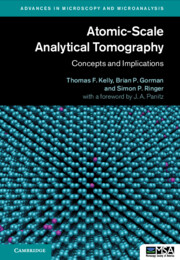Book contents
- Atomic-Scale Analytical Tomography
- Advances in Microscopy and Microanalysis
- Atomic-Scale Analytical Tomography
- Copyright page
- Dedication
- Contents
- Foreword
- Atomic-Scale Analytical Tomography (ASAT)
- Preface
- Acknowledgments
- Introductory Section
- Core Section
- 4 Has ASAT Been Achieved?
- 5 How ASAT Might Be Achieved
- 6 Instrumentation for ASAT
- 7 Practical ASAT
- 8 Toward Real-Space Crystallography
- 9 Experimental Metrics for ASAT
- Implications Section
- Index
- References
6 - Instrumentation for ASAT
from Core Section
Published online by Cambridge University Press: 03 March 2022
- Atomic-Scale Analytical Tomography
- Advances in Microscopy and Microanalysis
- Atomic-Scale Analytical Tomography
- Copyright page
- Dedication
- Contents
- Foreword
- Atomic-Scale Analytical Tomography (ASAT)
- Preface
- Acknowledgments
- Introductory Section
- Core Section
- 4 Has ASAT Been Achieved?
- 5 How ASAT Might Be Achieved
- 6 Instrumentation for ASAT
- 7 Practical ASAT
- 8 Toward Real-Space Crystallography
- 9 Experimental Metrics for ASAT
- Implications Section
- Index
- References
Summary
Based on the discussion in Chapters 4 and 5, combining information from both electron microscopy, presumably (Scanning) Transmission Electron Microscopy ((S)TEM), and Atom Probe Tomography (APT) is a likely path toward ASAT. Experimentally, concurrent (S)TEM and APT may appear to be a straightforward experiment, but the instrumentation required can be complex and require significant capital investment. In this chapter, we consider what instrumentation is necessary for each technique and what could be done to both simplify and improve the ASAT technique in a combined instrument that solves many of the complexities in experimentation. Experimental conditions such as vacuum pressure, cryogenic temperatures, electron imaging and diffraction, laser wavelength and positioning, and specimen holder designs must all be taken into account.
Keywords
- Type
- Chapter
- Information
- Atomic-Scale Analytical TomographyConcepts and Implications, pp. 98 - 124Publisher: Cambridge University PressPrint publication year: 2022

